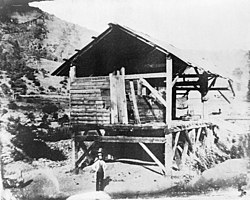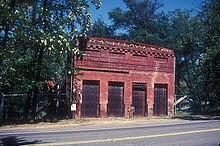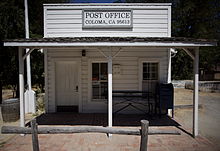world.wikisort.org - USA
Coloma (Nisenan: Cullumah, meaning "beautiful") is a census-designated place[6] in El Dorado County, California, US. It is approximately 36 miles (58 km) northeast of Sacramento, California. Coloma is most noted for being the site where James W. Marshall found gold in the Sierra Nevada foothills, at Sutter's Mill on January 24, 1848,[3] leading to the California Gold Rush. Coloma's population is 529.
Coloma, California | |
|---|---|
census-designated place | |
 Coloma, 2025 | |
 Location of Coloma in El Dorado County, California | |
 Coloma, California Position in California | |
| Coordinates: 38°48′09″N 120°53′41″W | |
| Country | United States |
| State | California |
| County | El Dorado |
| Area | |
| • Total | 3.35 sq mi (8.69 km2) |
| • Land | 3.35 sq mi (8.69 km2) |
| • Water | 0.00 sq mi (0.00 km2) 0% |
| Elevation | 764 ft (233 m) |
| Population (2020) | |
| • Total | 2,025 |
| • Density | 155.29/sq mi (59.96/km2) |
| Time zone | UTC-8 (Pacific (PST)) |
| • Summer (DST) | UTC-7 (PDT) |
| Area code | (530) |
| GNIS feature ID | 1655915; 2582981 |
| U.S. Geological Survey Geographic Names Information System: Coloma, California; U.S. Geological Survey Geographic Names Information System: Coloma, California | |
Coloma | |
U.S. National Register of Historic Places | |
U.S. National Historic Landmark District | |
 Sutter's Mill 1850 | |
| Nearest city | Placerville, California[3] |
| Area | c. 250 acres (100 ha) |
| Built | 1848 |
| NRHP reference No. | 66000207[4] |
| Significant dates | |
| Added to NRHP | October 15, 1966[4] |
| Designated NHLD | July 4, 1961[5] |
The settlement is a tourist attraction known for its ghost town and the centerpiece of the Marshall Gold Discovery State Historic Park. Coloma was designated a National Historic Landmark District on July 4, 1961.[3][5]
It lies at an elevation of 764 feet (233 m).[2]
Etymology
The name comes from the Nisenan Indian name for the valley in which Coloma is located: Cullumah, meaning 'beautiful.' Coloma is on the South Fork American River that runs through the valley and was built on the original Indian village of Koloma.[7] Former spellings include "Colluma" and "Culloma".[8].
History
Coloma grew around Sutter's Mill following the finding of gold.[8] A post office was established in 1849 under the name Culloma, changing to Coloma in 1851.[8]
One of Coloma's earliest settlers was Silas Sanderson (1824–1886), who went on to become the 7th Chief Justice of California.[9] Another was Nancy Gooch, who was one of the first black women to succeed in California.
Ghost town

While some people still live in the area, Coloma is considered something of a ghost town because civic buildings such as the jail have been abandoned and left to decay, and other buildings from its boom era (1847–1852) have been converted into museums and other historical displays. The tailrace of Sutter's Mill remains, as does a nearby reconstruction.[10]
In reality the meaningfulness of the township of Coloma has dissipated as residents who live in the wider Coloma Valley area generally share a community spirit.[11]
The local economy is based predominantly on agriculture[12] and tourism. Of particular note is the rafting industry as the South Fork American River is one of the most popular white-water trips in North America.[13]
Demographics
| Historical population | |||
|---|---|---|---|
| Census | Pop. | %± | |
| 2020 | 521 | — | |
| U.S. Decennial Census[14] | |||


The 2010 United States Census[15] reported that Coloma had a population of 529. The population density was 157.7 inhabitants per square mile (60.9/km2). The racial makeup of Coloma was 462 (87.3%) White, 4 (0.8%) African American, 3 (0.6%) Native American, 8 (1.5%) Asian, 0 (0.0%) Pacific Islander, 15 (2.8%) from other races, and 37 (7.0%) from two or more races. Hispanic or Latino of any race were 63 people (11.9%).
The Census reported that 429 people (93.6% of the population) lived in households, 34 (6.4%) lived in non-institutionalized group quarters, and 0 (0%) were institutionalized.

There were 216 households, out of which 44 (20.4%) had children under the age of 18 living in them, 116 (53.7%) were opposite-sex married couples living together, 14 (6.5%) had a female householder with no husband present, 10 (4.6%) had a male householder with no wife present. There were 22 (10.2%) unmarried opposite-sex partnerships, and 2 (0.9%) same-sex married couples or partnerships. 51 households (23.6%) were made up of individuals, and 20 (9.3%) had someone living alone. The average household size was 2.29. There were 140 families (64.8% of all households); the average family size was 2.64.
The population was spread out, with 69 people (13.0%) under the age of 18, 31 people (5.9%) aged 18 to 24, 127 people (24.0%) aged 25 to 44, 200 people (37.8%) aged 45 to 64, and 102 people (19.3%) who were 65 years of age or older. The median age was 49.0 years. For every 100 females, there were 115.9 males. For every 100 females age 18 and over, there were 120.1 males.
There were 251 housing units at an average density of 74.8 per square mile (28.9/km2), of which 216 were occupied, of which 153 (70.8%) were owner-occupied and 63 (29.2%) were occupied by renters. The homeowner vacancy rate was 1.3%; the rental vacancy rate was 12.5%. 355 people (67.1% of the population) lived in owner-occupied housing units, and 140 people (26.5%) lived in rental housing units.
Politics
In the state legislature, Coloma is in the 1st Senate District, represented by Republican Brian Dahle,[16] and the 5th Assembly District, represented by Republican Frank Bigelow.[17]
Federally, Coloma is in California's 4th congressional district, represented by Republican Tom McClintock.[18]
Climate
According to the Köppen Climate Classification system, Coloma has a warm-summer Mediterranean climate, abbreviated "Csa" on climate maps.[19]
Sister cities
- Clunes, Australia
Notable people
- Nancy Gooch
References
- "2020 U.S. Gazetteer Files". United States Census Bureau. Retrieved October 30, 2021.
- U.S. Geological Survey Geographic Names Information System: Coloma, California
- Allen W. Welts (February 1970). "National Register of Historic Places Inventory-Nomination: Marshall Gold Discovery State Historic Park / Coloma" (PDF). National Park Service. Retrieved 2009-06-22.
{{cite journal}}: Cite journal requires|journal=(help) and Accompanying one image, from 1850s (213 KB) - "National Register Information System". National Register of Historic Places. National Park Service. July 9, 2010.
- "Coloma". National Historic Landmark summary listing. National Park Service. Archived from the original on 2012-10-08. Retrieved 2008-06-29.
- U.S. Geological Survey Geographic Names Information System: Coloma, California
- U.S. Geological Survey Geographic Names Information System: Koloma
- Durham, David L. (1998). California's Geographic Names: A Gazetteer of Historic and Modern Names of the State. Clovis, Calif.: Word Dancer Press. p. 468. ISBN 1-884995-14-4.
- The State Register and Year Book of Facts: 1859. Henry G. Langley and Samuel A Morison. 1859.
- "Marshall Gold Discovery SHP". California Depart of Parks and Recreation. Retrieved 20 May 2012.
- "Coloma-Lotus News".
- "After the Gold Rush: Agriculture".
- "NO on El Dorado County Measure W – Coloma-Lotus Association of Merchants Opposes". Archived from the original on 2015-09-23. Retrieved 2015-06-12.
- "Census of Population and Housing". Census.gov. Retrieved June 4, 2016.
- "2010 Census Interactive Population Search: CA – Coloma CDP". U.S. Census Bureau. Archived from the original on July 15, 2014. Retrieved July 12, 2014.
- "Senators". State of California. Retrieved April 5, 2013.
- "Members Assembly". State of California. Retrieved April 5, 2013.
- "California's 1st Congressional District - Representatives & District Map". Civic Impulse, LLC. Retrieved March 3, 2013.
- "Coloma, California Köppen Climate Classification (Weatherbase)". Weatherbase.
External links
- Historic American Buildings Survey (HABS) No. CA-1301, "Sutter's Mill, American River (submerged), Coloma vicinity, El Dorado County, CA"
- HABS No. CA-1309, "James W. Marshall Cabin, Marshall Monument Road, Coloma, El Dorado County, CA"
- HABS No. CA-1374, "Coloma Road (House), Placerville, El Dorado County, CA"
- HABS No. CA-1376, "Post Office, Main Street, Coloma, El Dorado County, CA"
- HABS No. CA-1377, "Barn, Coloma, El Dorado County, CA"
- HABS No. CA-1378, "House, Coloma, El Dorado County, CA"
- HABS No. CA-1380, "Chinese Store (Ruins), Main Street, Coloma, El Dorado County, CA"
- HABS No. CA-1381, "Meyer's Dance Hall & Saloon, Shingle Spring Road, Coloma, El Dorado County, CA"
- HABS No. CA-1503, "Sierra Nevada Hotel, Coloma, El Dorado County, CA"
- Local visitor's guide
На других языках
[de] Coloma (Kalifornien)
Coloma (auch Colluma oder Culloma) ist ein zu Statistikzwecken definiertes Siedlungsgebiet (Census-designated place) im El Dorado County (Kalifornien).- [en] Coloma, California
[es] Coloma (California)
Coloma es una comunidad no incorporada del Condado de El Dorado, California, de los Estados Unidos; se encuentra aproximadamente a 15 km al noroeste de Placerville. Coloma es famoso por ser el sitio donde se descubrió oro el 24 de enero de 1848; descubrimiento que llevó a la fiebre del oro de California en el siglo XIX. El descubrimiento fue realizado por James W. Marshall en Sutter's Mill.[2][ru] Колома (Калифорния)
Колома (англ. Coloma) — бывший небольшой город в округе Эль-Дорадо, штат Калифорния, США. Наиболее известен как место, где Джеймс Маршалл впервые открыл золото в Калифорнии, вблизи лесопилки Саттера в 1848 году, что дало начало Калифорнийской золотой лихорадке. По переписи 2010 года население Коломы составляет 529 человек.Другой контент может иметь иную лицензию. Перед использованием материалов сайта WikiSort.org внимательно изучите правила лицензирования конкретных элементов наполнения сайта.
WikiSort.org - проект по пересортировке и дополнению контента Википедии
